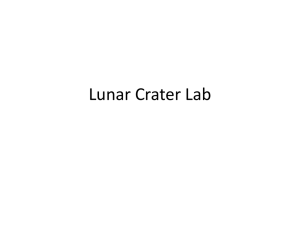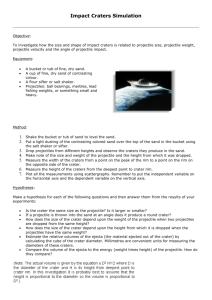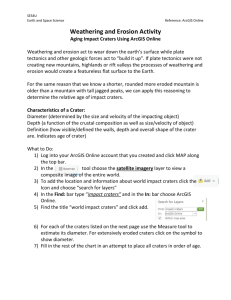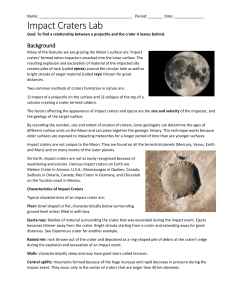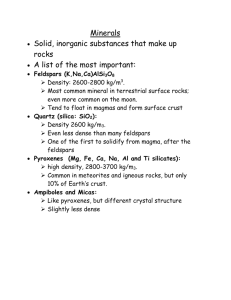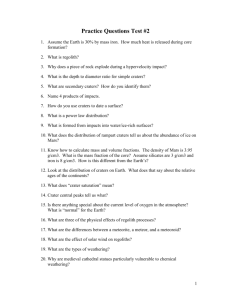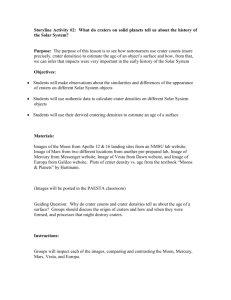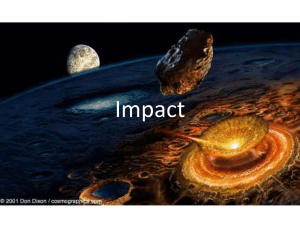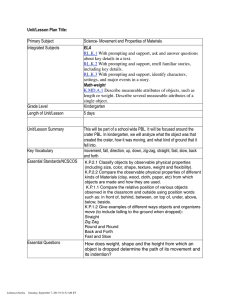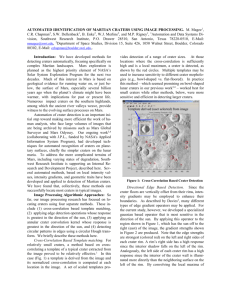GEOLOGY 102
advertisement
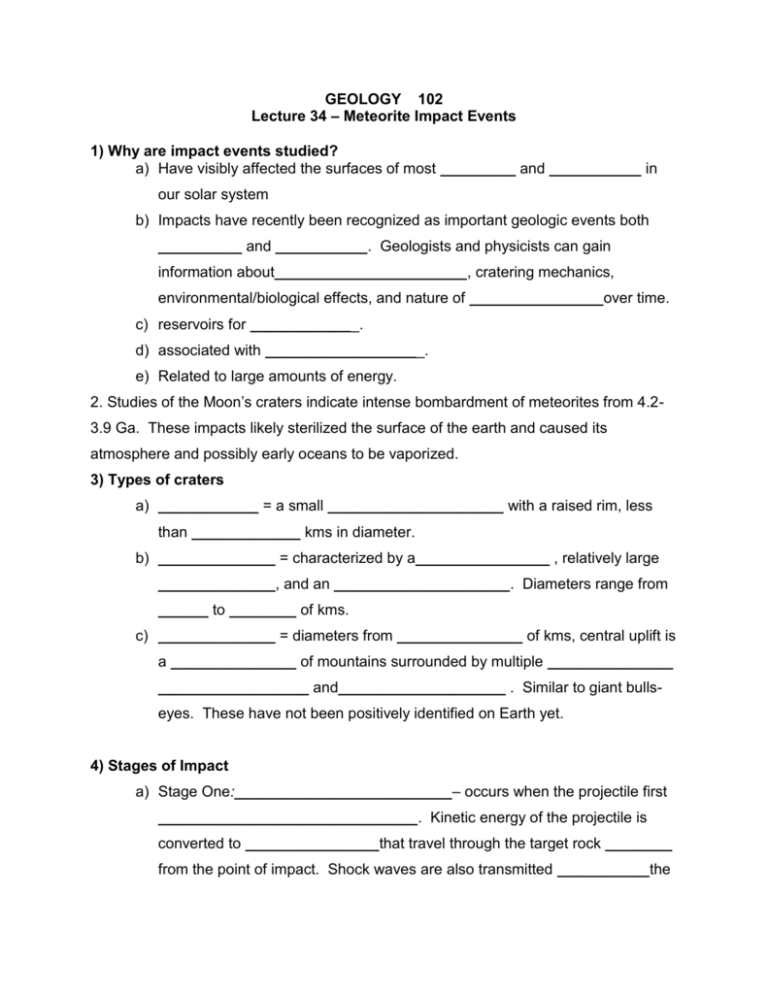
GEOLOGY 102 Lecture 34 – Meteorite Impact Events 1) Why are impact events studied? a) Have visibly affected the surfaces of most _________ and ___________ in our solar system b) Impacts have recently been recognized as important geologic events both __________ and ___________. Geologists and physicists can gain information about_______________________, cratering mechanics, environmental/biological effects, and nature of ________________over time. c) reservoirs for _____________. d) associated with ___________________. e) Related to large amounts of energy. 2. Studies of the Moon’s craters indicate intense bombardment of meteorites from 4.23.9 Ga. These impacts likely sterilized the surface of the earth and caused its atmosphere and possibly early oceans to be vaporized. 3) Types of craters a) ____________ = a small _____________________ with a raised rim, less than _____________ kms in diameter. b) ______________ = characterized by a________________ , relatively large ______________, and an _____________________. Diameters range from ______ to ________ of kms. c) ______________ = diameters from _______________ of kms, central uplift is a _______________ of mountains surrounded by multiple _______________ __________________ and____________________ . Similar to giant bullseyes. These have not been positively identified on Earth yet. 4) Stages of Impact a) Stage One:__________________________– occurs when the projectile first _______________________________. Kinetic energy of the projectile is converted to ________________that travel through the target rock ________ from the point of impact. Shock waves are also transmitted ___________the projectile often causing ________________ of the projectile. Peak shock wave pressures can exceed _________ (1GPa = 100kbar). For most impact events, this stage lasts ______________ second. b) Stage Two: _______________ – actual impact crater is opened. Rock located at shallow depths moved _________ and ___________. At deeper depths, rock dominantly moves ___________ and ___________. These movements produce a___________________. A ________ impact crater can be excavated in _____________ minutes. b) Three: ________________– crater differentiation occurs. If projectile is relatively _________, a simple crater will form due to ________________ and______________________. If the projectile is______, a complex crater will form due to ____________________(forming the central peak). Simple definition... “when things stop falling.” Crater Projectile Diameter Diameter 35 m 2m Energy (J) 2.1 x 1012 Frequency of Comparable Terrestrial Impact (#/m.y.) Event 250,000 Minimum damaging earthquake, M=5 1.1 km 55 m 6.2 x 1016 540 Mt. St. Helens eruption, blast only 6.9 km 350 m 1.5 x 1015 20 Largest recorded earthquake, M=9.6 31 km 1.5 km 1.3 x 1021 1.4 Total annual heat flow from the Earth 200 km 10 km 3.7 x 1023 0.007 Largest known impact structure on the Earth 5) Where are impact craters located? a) More than ________________have been recognized on the Earth. Notice the concentration of craters in N. America, Europe and Australia. This is not because objects preferentially impacted in those areas!! Identification of impact craters on the Earth is limited by: 1. ______________ (jungles!) 2. burial by ______________ 3. _________________. b) There are _________________ located in_______________. Probably best known in North America is the _________________ (aka Meteor Crater) in Arizona. Diameter = 1.186km, age = 0.049 million years. c) The smallest crater on the Earth is the ___________________ in Kansas. Diameter = 0.015km (49.8 ft!), age = <0.001 million years (~1000 years.) d) The largest crater on the Earth is _______________ in South Africa. Diameter = 300km (186 miles), age = ~2 billion years. 6) Effects of an impact: Local a) rock/mineral deformation both on a large and small scale a. large scale _______________ and_______________. 2-6 GPa b. shattercones = cones with distinctive____________________. Occur in fine-grained rocks like limestone. 2-30 GPa. c. __________________ in minerals = quartz! Features include: 1) grain___________. 5-7 GPa 2) __________________________________________ (PDFs) – fine lineations along crystallographic axes. 8-25 GPa 3) Conversion to ____________________ polymorphs (coesite and stishovite). 2-10 GPa d. Microspherules formed from __________________ of droplets of molten rock e. Ir - platinum group element occurs in great abundance only at or near impact events, its only common source is extraterrestrial (i.e. meteorites) b) _____________________ of target rock. 30-100 GPa 7) Effects of an impact: Global, these are controversial! a) extinction events a. ______ in atmosphere causing________________. Volcanic ash has been linked to global dust clouds. b. ________________ of carbonate rocks may cause release of _______ causing global ______________. ***Note! There are many discrepancies!! Example: _______________ and the _______________, Yucatan Peninsula, Mexico. b) hot spots, flood basalts, continental rifting a. good ideas but no scientific evidence to prove it! 7) Recognition and identification of craters: What to look for! a) a _________________ (if not covered by vegetation, sediment, or destroyed). Sometimes craters are filled with water. But (!!) how would you tell this from any other hole in the ground (sinkholes, volcanic calderas, etc...)? a. look for ____________________ minerals, _________________________ (PDFs) and shatter cones b. _____________ fragments. b) if the crater was destroyed? a. ______________ (only from extraterrestrial sources) b. ________________ in rock layers Example: ___________________, Nevada contains shocked quartz but so far a crater has not been identified.


